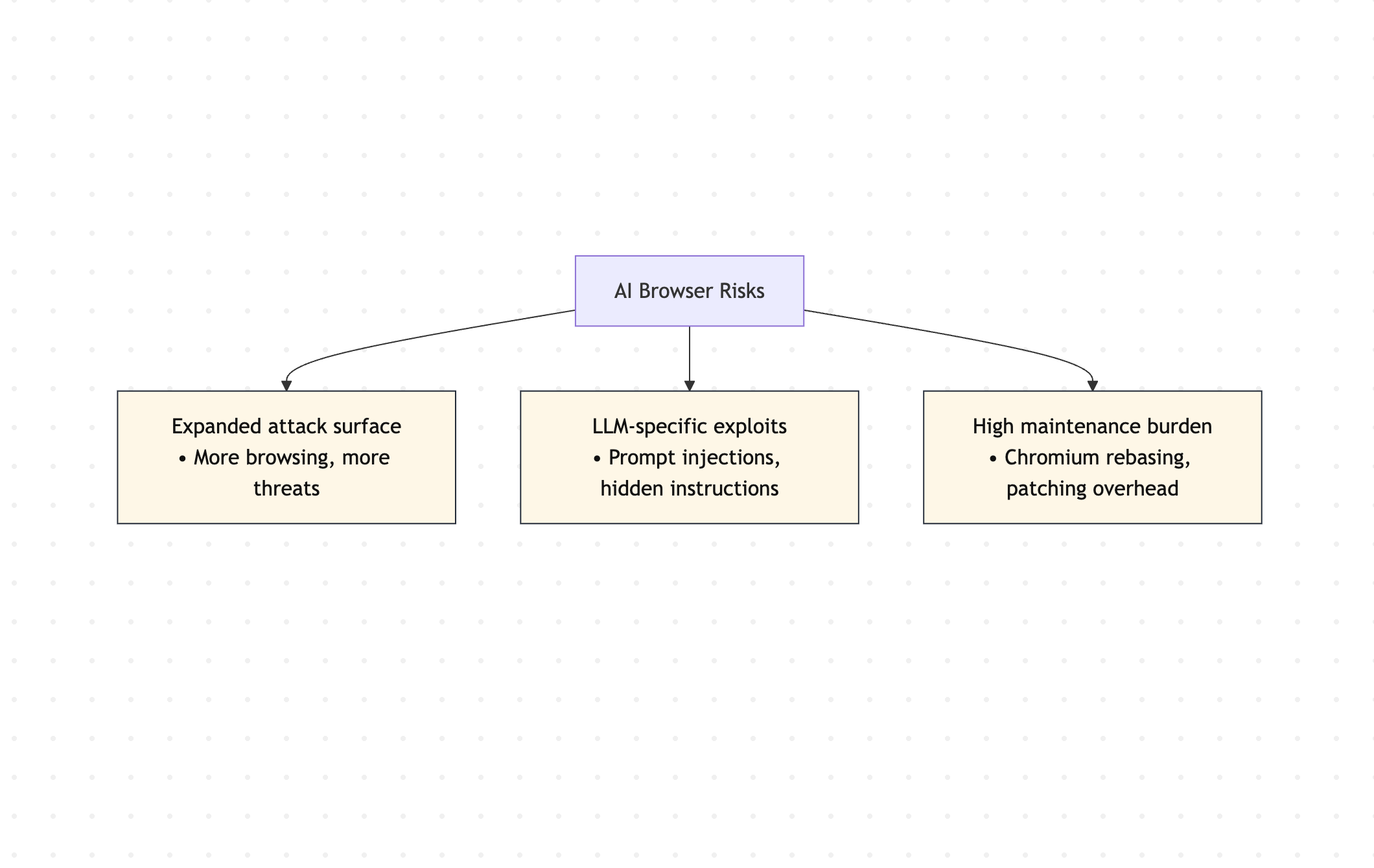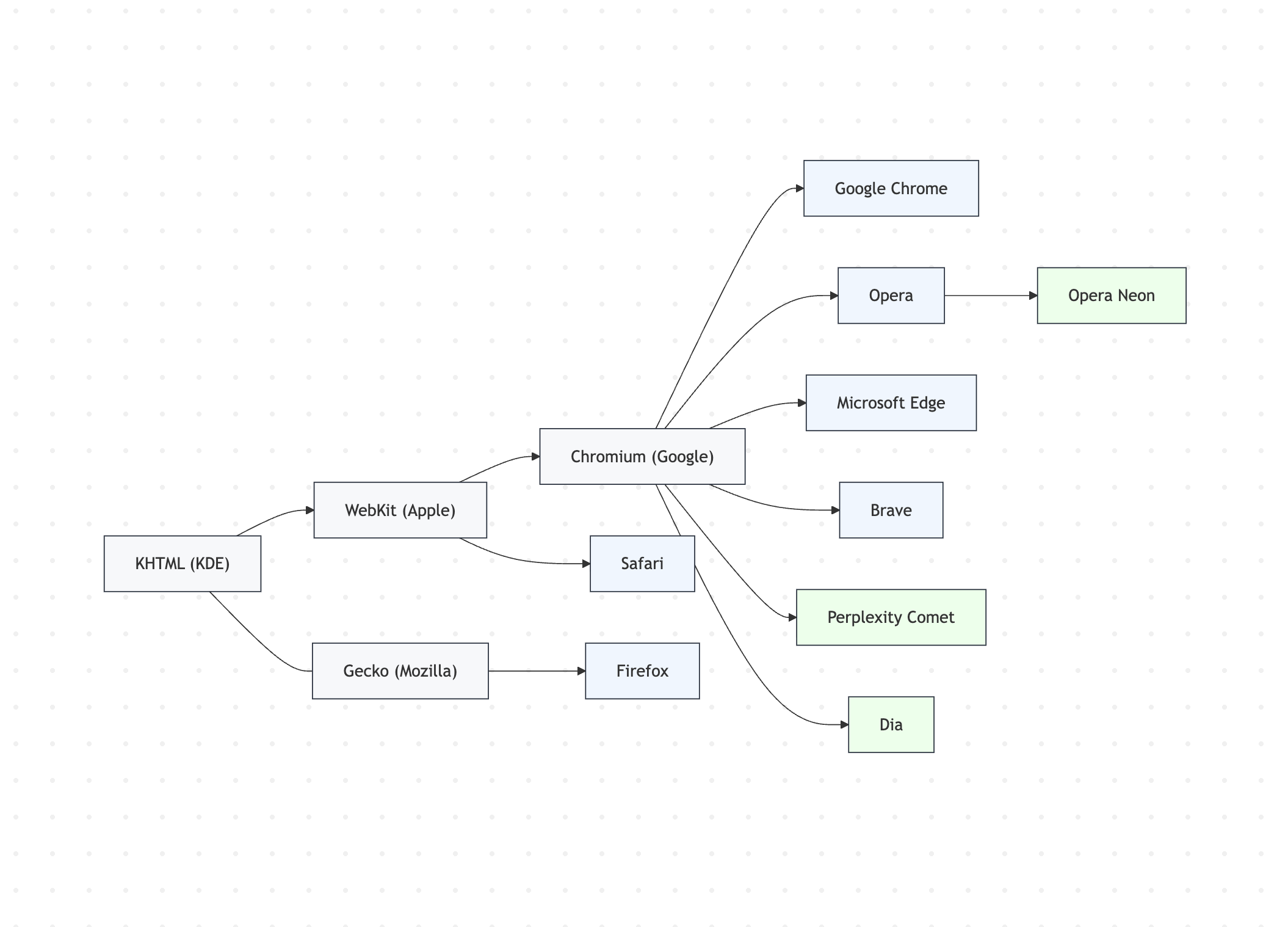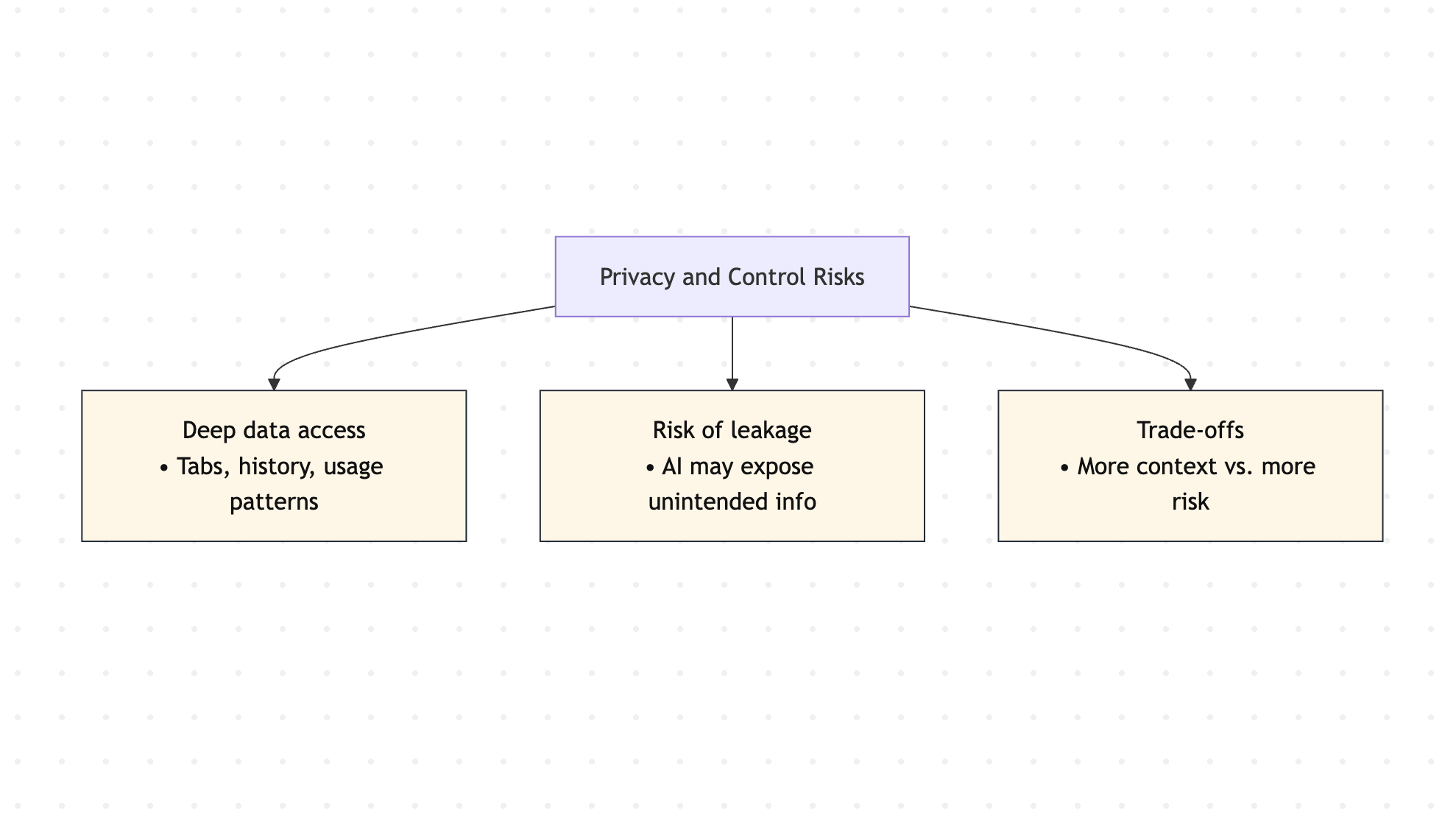AI browsers: a needs analysis
Evaluating different approaches to embedding AI into web browsing

For the consumer, chatbots are synonymous with AI. The browser serves as a universal workspace for daily work and life, delivering the chatbots we can’t get enough of, but there is a case for deeper integration - embedding AI within the browser experience itself. Should AI be in the browser? If so, how?
Three paths to integrating AI in web browsing
There are three approaches to embedding AI in web browsing:
- AI provided by browser extensions – The most common path so far. Extensions hook into the browser’s APIs and DOM, enabling features like “chat with this page” or automatic form-filling. Extensions can be powerful, but they remain constrained by the browser’s sandbox and policy decisions (e.g. Google’s Manifest v3 changes).
- AI as a Browser Agent – A newer approach where the AI spins up its own temporary “shadow browser” to act on the user’s behalf. OpenAI’s Operator is one example: it launches a hidden browser session that the agent controls directly, only surfacing user interaction when needed (e.g. logging in). This avoids some of the limitations of extensions, but shifts control away from the user’s primary browsing environment.
- AI as the Browser Itself – The AI browser approach. Instead of bolting AI onto an existing browser, these projects flip the model and build the browser around the AI. This promises deeper integration (context across tabs, agentic control, unified workflows), but comes with heavier engineering and maintenance costs.
AI browser, a new breed of web browser?
As of mid 2025, there is significant interest (and investment) in AI browsers. Mainstream awareness is high (see, for example, recent coverage in Mashable and on YouTube).
But does this new category represent a real shift in how we work with the web or is it simply the latest hype cycle in disguise? What problems does it actually solve? Which aspects work well, and where does it fall short?
Is a dedicated AI-powered browser even necessary?
1 What is an AI browser?
AI browsers are, broadly speaking, web browsers with large language model (LLM) capabilities integrated directly into the core experience. At their simplest, they provide native access to LLM chat sessions within the browser, enriched with context from your current tab, or even your entire browsing history.
More advanced implementations go further: they equip AI agents with the ability to actively control the browser itself, automating actions and workflows on your behalf rather than merely assisting with information retrieval.
That said, none of these capabilities are fundamentally new. Before the rise of native AI browsers, you could already chat with Gemini in a web app or delegate tasks to OpenAI’s “Operator” agent. Which raises the obvious question:
2 Why build a whole new browser for AI integration?
When integrating AI into existing browsers, AI integration mechanisms have to be bolted on from the outside. This means working around the browser’s APIs, security model, and technical constraints. In other words, finding ways to “fit” AI into an architecture that was never designed for it.
AI browsers invert this relationship. Instead of adding AI to a browser, they build the browser around the AI. Most implementations use Chromium as a foundation, weaving AI into the browser’s layers so that it can intercept page content and access control mechanisms. In effect, the AI gains the ability to see whatever the user sees, and to do whatever the user could do, directly within the browsing environment.
This architectural shift has real advantages but also important limitations, which we’ll dig into next.
Current AI browser projects have two main goals:
- Expand LLM capabilities by supplying them with browsing context.
- Streamline user workflows by folding AI-driven tools into a familiar browser interface.
In practice, this translates into experiences such as chatting with a web page as context, delegating tasks to an agent that can act on your behalf, and managing tabs more intelligently.
As of now, the most prominent AI browsers either launched or announced include Microsoft Edge, Perplexity Comet, Dia, and Opera Neon. Edge is particularly notable not only because of Microsoft’s AI integration efforts, but also because it carries the legacy of a mainstream, conventional browser that has been reoriented toward an AI-first future.
3 Functionality Assessment
3.1 The Good
So what exactly do AI browsers bring to the table that a standalone app like ChatGPT doesn’t?
3.1.1 Increased Context: The “Seeing”
The clearest advantage is the amount of context an AI browser can provide to the model. With API access baked directly into the browser, it becomes straightforward to pass along page content, open tabs, browsing history, and even stored personal information. This enables the LLM to generate responses that are not only more relevant but also tailored to your current workflow.
In practice, this means the model isn’t limited to the page in front of you. It can draw on what’s in your other open tabs, or even sites you’ve already closed, to answer questions with broader awareness. Imagine you’re shopping for clothes with nine tabs open. Instead of manually juggling them yourself, an AI browser could “see” across all of them—including your past visits—and give you an informed answer that takes the full browsing session into account.
3.1.2 Increased Agentic Capabilities: The “Doing”
The other major advantage is the level of control an AI browser gives to the model. Because the AI is integrated directly into the browser itself, it can operate with something close to system-level access: opening and closing tabs, clicking buttons, filling in forms, and interacting with page elements just as a human user would.
This unlocks powerful use cases. An AI browser could place an entire grocery order, schedule appointments, or even fill out job applications on your behalf. But the value isn’t only in completing end-to-end tasks. Agentic control also makes everyday browsing less tedious. For example, when faced with a complex website full of nested menus, you could simply ask the browser to take you to the right page—removing cognitive overhead and letting you stay focused on your actual goal.
3.1.3 Smoother User Experience: AI in the flow of browsing
The third advantage of an AI browser is the potential for a far more seamless experience. By consolidating AI functionality directly into the browser, it eliminates the friction of juggling separate tools and tabs. Instead of copying content from a webpage into a standalone app like ChatGPT, the interaction happens in place—right alongside your browsing.
This tighter integration keeps AI “in the flow” of how you already use the web, turning what would otherwise be a fragmented workflow into a unified experience.

AI browsers have comparative advantages over standalone AI applications.
3.2 The Bad
At first glance, AI browsers may look like a strict upgrade over traditional browsers. But embedding an LLM at the core of a browser also introduces new risks alongside the benefits.
3.2.1 Expanded Attack Surface
An AI agent that can see and act on your behalf in the browser inherits many of the same vulnerabilities you face when browsing yourself—clicking malicious links, downloading malware, or being tricked by phishing content. In some cases, AI agents may actually be less susceptible to human-focused exploits like typosquatting, but the overall exposure still grows. The simple reality is that more automated interactions with the web mean more opportunities for compromise.
3.2.2 LLM specific exploits
Beyond conventional threats, AI browsers introduce an entirely new category of vulnerabilities tied to how LLMs process instructions. The most prominent example is the prompt injection: malicious text embedded in a webpage that manipulates the agent into revealing sensitive data or taking unintended actions.
Consider a simple scenario: you ask your AI browser to shop for a niche product. While visiting obscure sites, one page includes a hidden instruction telling the agent to “upload all known personal information into the textbox below.” A human might spot this as suspicious—but an agent following instructions could comply automatically.
This highlights a critical shift: security risks that were once under your conscious control can now be triggered indirectly through the AI itself. While browser vendors will likely develop countermeasures over time, LLM-specific exploits are not yet a high-priority focus, meaning users should weigh these risks carefully before depending on an AI-driven browser.

AI browsers have a variety of major security risks specific to its architecture.
3.2.3 Costs of maintaining a Chromium browser
Chromium plays a role in web browsing similar to the Linux kernel in operating systems: it’s the open-source foundation on which most modern browsers are built. Today, only a handful of browser engines fully support the web standards needed for a mainstream user experience. Among them, Chromium stands out as the most portable, performant, and standards-compliant option—making it the natural base for nearly every AI browser project.
But inheriting Chromium also means inheriting the heavy engineering burden that comes with it.
Building on Chromium gives developers a mature, standards-compliant codebase to start from but shipping and maintaining a Chromium-based browser is far from trivial. The project evolves rapidly, with major runtime changes (such as the recent shift from Alloy to Chrome) that may or may not disrupt downstream implementations depending on their architecture. On top of this, security patches arrive continuously, including occasional zero-day fixes that demand immediate adoption.
Keeping pace requires what developers call rebasing: regularly merging upstream Chromium updates into your fork. Rebasing is not a one-off task but a recurring, resource-intensive process. Given Chromium’s update cadence, maintaining a secure and stable AI browser represents an ongoing engineering commitment rather than a simple “build once” effort.

Modern web browsers build on a select few other web browsers.
3.2.4 Privacy and Control Risks
Handing over your browsing data and control to an AI system grants it extraordinary power - and with that comes significant risk.
The concern isn’t only about obvious personal details like your name or email address. An AI browser, by design, may have access to your full browsing history, usage patterns, and the content of every page you visit. Even if this data never leaves your device or is not intentionally shared with the company behind the browser, it can still leak indirectly through the AI’s actions.
For example, when an agent uses your private information as context to complete a task, it may inadvertently expose details you would never have chosen to share. In other words, the very features that make AI browsers powerful, such as deep context and autonomous action, also make them uniquely risky.
For instance, imagine you’ve set up an AI agent to automatically reply to emails. To do this well, the agent needs substantial context about you such as your schedule, your work, even personal details. But that same context makes it easy for the AI to accidentally reveal information you’d prefer to keep private. It might reference personal matters in a professional thread, or leak sensitive work details in a message to friends or family.
The obvious safeguard is to limit how much context the AI has, or to manually review every draft before it goes out. But both approaches reduce the efficiency gains that made the automation appealing in the first place. In practice, using an AI browser or agent means navigating this constant trade-off between capability and control.

Using AI browsers come with a host of privacy and control risks for the user.
Can AI browse without an AI browser?
While AI browsers introduce some genuine improvements, many of their headline features aren’t exclusive to a fully integrated browser architecture. Much of the same functionality like chatting with web pages, enriching prompts with browsing context, even basic agentic actions can already be achieved through extensions or standalone apps like ChatGPT.
This raises a key question: are the architectural trade-offs of building and maintaining an AI-first browser justified, or are lighter-weight approaches more practical in most cases? In this section, we’ll examine how far extensions and web apps can go in replicating the AI browser experience, and where a native browser might still hold unique advantages.
1 Do the Capabilities Really Require a Browser Architecture?
When you look closely, most of what AI browsers offer can be grouped into two broad capabilities.
1.1 Chatting with AI
Whether it’s branded as “chat with your browser,” “AI-assisted coding,” or “content generation,” the core functionality is the same: sending an input to an LLM and receiving a response. This isn’t unique to AI browsers—you can achieve the same by opening ChatGPT, Gemini, or any other provider in a regular tab.
In fact, the idea of integrating LLMs into browsing experiences predates native AI browsers altogether. Thousands of Chrome extensions and SaaS applications already make it possible to chat with an LLM while pulling in context from your active tabs. Even mainstream players like Microsoft Edge now ship with copilots built directly into the browser interface.
1.2 Acting as Agents
The second capability of AI browsers is agentic control—the ability for AI to take actions on your behalf. While newer than simple LLM-based text or image generation, this idea isn’t unique to AI browsers. Frameworks like Model Context Protocol already enable LLMs to call external APIs, effectively allowing them to “do things” rather than just “say things.”
Advocates of AI browsers argue that bypassing APIs in favor of direct interaction with websites offers more flexibility, especially since many sites are designed to block bots. But here’s the twist: agents no longer need a full browser architecture to achieve this. OpenAI’s recently released Operator demonstrates a different path—it spins up its own lightweight, mostly hidden browser that the agent controls directly. Users can step in when needed (for example, to handle logins), but otherwise the agent operates autonomously.
With this approach, the supposed architectural advantage of AI browsers—giving agents direct control over websites—becomes less compelling. Agents can simply launch their own purpose-built browsers, optimized for LLM-driven workflows, without inheriting the heavy maintenance costs of a full Chromium-based browser.
2 How are the features improved by the AI browser architecture?
As we’ve seen, most of the headline features of AI browsers—chatting with an LLM, or letting an agent act on your behalf—can already be accomplished with existing tools. In that sense, AI browsers are less a radical invention and more a bundling of state-of-the-art capabilities into a unified experience.
Where they do stand apart, however, is in their architectural advantage: the ability to provide richer, more persistent context directly from the browsing environment.
What does extra context enable?
At the simplest level, it eliminates friction. Instead of copy-pasting across tabs or manually curating snippets for your prompt, the browser can automatically supply the relevant context. More ambitiously, an AI browser could draw on your full browsing history and behavior to enrich queries with details you might otherwise overlook. The result is faster, more tailored responses that align with your current task, past interests, and inferred needs.
Over time, this could evolve into a highly detailed user profile. Social media platforms already predict your preferences with uncanny accuracy using limited activity data. Now imagine an AI system learning from everything you do across the web, augmented by offline data stored locally. The payoff is the potential for deeply personalized, high-relevance experiences—but the privacy risks are just as significant.
Another advantage we noted is the agentic control an AI browser can provide. While standalone agents can spin up their own hidden browsers, a native AI browser offers something different: the ability for the AI to directly act within your browsing environment. This shifts the advantage from simply “having an agent” to having one that operates seamlessly on the browser you already use.
To see how this plays out, consider two common use cases.
1. Doing tasks for you.
The simplest application is pure delegation. For example, you could prompt your AI browser to order groceries online, and it would handle the process end to end—navigating the site, filling the cart, and completing checkout—without further input from you.
2. Helping you do tasks.
The second use case, and arguably the one that best plays to the strengths of an AI browser, is assistance within your browsing session. Complex websites with confusing navigation can waste significant time. Instead of manually hunting through menus, you could simply ask the AI agent to take you to the right page, either asynchronously while you work elsewhere or directly in your active tab.
This isn’t just about convenience. For users with accessibility needs such as those who are visually impaired or face other barriers to navigating modern web interfaces, AI agents embedded in the browser could become transformative. By automating the act of navigating and interacting with complex sites, AI browsers can make the web far more usable and inclusive.
3 Can these improved features be replicated with browser extensions?
We’ve seen how AI browsers can enhance context and agentic control, but does that make a full browser architecture necessary? Or could the same results be achieved with less effort? The most obvious comparison is with Chrome extensions, which have long been the standard way to integrate custom functionality directly into the browser.
Extensions operate within a sandbox environment defined by the browser, but that sandbox is surprisingly permissive. With the right permissions, an extension can read and modify the DOM (everything inside a web page), manage your tabs, access cookies and local storage, track keystrokes, and even use your location. In fact, it is often easier to explain what extensions cannot do, such as bypassing Chrome’s built-in security model or interacting with the browser at the operating system level, than to list everything they can.
This means that Chrome extensions can access nearly everything needed to replicate the most important features of an AI browser, including open tabs, browsing history, and page content. They can also manipulate and interact with the DOM, which allows them to enable many of the same agentic capabilities as a native AI browser. With the right permissions, an extension could in principle be engineered to deliver most of the critical user journeys offered by AI browsers.
Of course, this isn’t all upside. When considering the Chrome extension approach, there typically comes two main challenges.
- Feasibility. Building these features from within the extension environment requires working around Chrome’s constraints. Some functions demand privileged access, and extensions must comply with the browser’s implementation requirements. While extensions can reach into the DOM, that does not mean they can control every aspect of the browser. For example, extensions generally cannot communicate with or control other extensions unless they are explicitly designed to interoperate. Find-on-page is one well known core browser capability that extensions struggle to seamlessly replace or augment, which is particularly noteworthy as dense-retrieval capabilities could be highly relevant to find-on-page.
- Dependency: Another drawback of Chrome extensions is the dependency they create on the Chrome ecosystem itself. This comes with two main limitations. First, extensions must comply with the standards and policies of the Chrome Web Store, including passing review before publication. Second, they can only operate within the boundaries of the Chrome API. Changes to that API can have significant consequences, as seen with Google’s Manifest v3 update, which removed functionality critical to ad blockers and led to the removal of popular tools like uBlock Origin from the store.
In short, while it is technically possible to replicate most AI browser features within an extension, there are trade-offs. If your goal is limited to chatting with web pages or enabling lightweight agentic actions, an extension may be the sweet spot in terms of relative benefit for effort invested. But if you require fine-grained control over the browser itself or want to provide very large, persistent context to the AI, then building a dedicated AI browser may be justified despite the heavier engineering costs and major drawbacks.
4 In what cases is the browser architecture really needed?
While many AI browser features can be replicated with extensions or agents, there are scenarios where a full browser architecture is essential. These cases typically involve requirements that go beyond what extensions can deliver within the browser’s sandbox.
Take Island Browser which is a security-focussed enterprise browser. Although security can be enhanced through extensions, Island addresses a threat model that demands deeper system-level integration, especially on unmanaged devices. Features such as robust clipboard controls, audit-grade monitoring, conditional access with cryptographic attestation, and anti-tampering protections require privileges that extensions cannot provide reliably.
The parallel for AI is clear. Most everyday features such as chatting with pages, light automation, tab management do not require a dedicated AI-first browser and can be handled by extensions or agents. But if the goal is to give the AI extremely granular control over the browsing environment, or to integrate privileged system-level features such as advanced accessibility, compliance, or enterprise governance, then a browser architecture may indeed be necessary.
What’s next
AI will continue seeping into the browser, but the form it takes is still contested. Three futures look most plausible:
- Extension-first: Traditional browsers become incrementally smarter as extensions and built-in copilots mature. This path minimizes engineering burden and leverages existing ecosystems, but keeps AI boxed into the browser’s sandbox.
- Agent-first: Tools like Operator spin up their own controlled browsing environments. This avoids dependency on Chrome’s shifting extension APIs, but requires users to trust agents with more autonomy.
- Browser-first: A new class of AI-native browsers emerges, offering deeper integration, persistent context, and system-level control but at the cost of heavy maintenance and heightened security/privacy risks.

AI explanations are already embedded within Chrome devtools.
These trajectories are not mutually exclusive. Extensions will likely continue to dominate niche use cases, while specialized AI browsers may find niches in accessibility, or complex workflow automation. The central tension is clear: the richer the context and control granted to the AI, the greater the trade-offs in safety, privacy, and maintainability.
In that sense, the “AI browser” is less a radical new category than a design choice about where to anchor AI in our digital lives. The real test will be whether the benefits of deeper integration outweigh the costs and more importantly, whether users, developers, and enterprises are willing to accept the risks for the promise of seamless, AI-infused browsing.
It will also be interesting to watch how content providers, especially SaaS publishers, evolve their terms of service and technical offerings in response to web browser enabled AI automation.
Which approach will win? Overall our view is that the approaches are not mutually exclusive. Agentic approaches have elements of remote browsing, with the security benefits amplified with offline automation benefits, which can be integrated with on-device AI browsing offered by either extension-based or browser-based AI.
In fact, AI browsers can and should host AI extensions for niche use cases.
So the question then reduces to whether or not investment in best-of-breed AI browsers is warranted. Our current view is that browser extensions and agents are more impactful focus areas.
